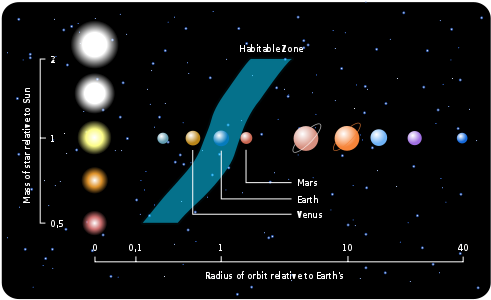Here are 7 points that make earth a habitable planet.
1. Galactic neighborhood

A galactic neighborhood is composed of galaxies, stars clusters and large revolving gas clouds that are gravitationally bound to us. Two massive bright spirals, the Milky way and the Andromeda galaxy, dominates a gravitationally bound group of around 40-50 galaxies known as Local group which spans a volume approximately 10 million light years in diameter.
Our galactic environment impacts habitability. Our solar system is located at the corner of Milky way galaxy and the reason that makes galaxy's edge a life favorable spot are:
- There is no near active gamma rays source.
- There is no near galactic center with high star density and ionizing radiation.
2. The stars around it have to be "stable".
Okay so, our galactic neighbor is stable now lets consider the biggest star of our solar system which is sun. For a planet to sustain life, it needs to have a stable star. Stars that fluctuate luminosity violently are poor candidate for hosting life. The solar variation for sun is ~0.1% over 11 year cycle.
Also the spectral class of the stars plays an important role in hosting life on a planet. Spectral class indicates the photospheric temperature. Spectral class needed for life are:
- The star should emit high frequency UV radiation to trigger ozone formation.
- It should not emit much radiation that the ionization destroys the life.
3.It should lie in a habitable zone.

Liquid water is essential to all the life on earth. So a habitable zone is the orbit region around a star where the planet could posses liquid water on it's surface.So, the definition of habitable zone is based on the hypothesis that extraterrestrial life would save this requirement and also the temperature of the surface of the planet should be not too hot or not too cold. Therefore the presence of water gives earth an upper edge over other planets.
4.It should not have very low mass.

Earth is a terrestrial planet and not a gas planet like Jupiter, Saturn, Uranus and Neptune. Also it has a higher mass which is large enough to have a liquid outer core(heat engine), atmosphere through gravity and metallic inner core(magnetic field).
5.It should have a magnetic field.

Our sun emits a large amount of solar winds. Solar wind is a stream of charged particles from star consisting of electron and protons. The presence of a liquid outer core leads to the movement of iron in it, which in turn generates magnetic field. The Earth's magnetic field serves to deflect most of the solar winds, whose charged particles would otherwise stripe away the ozone layer that protects the earth from harmful UV radiation.
6.It must rotate on its axis.

The earth rotates around its axis at tilt. Without a tilt the planet would become colder as warm weather would not move toward pole. Also it should not be radically tilted as it would make the season extreme. The speed of rotation also plays a major role for life to sustain. It should be relatively quick, so there is not much larger temperature difference between day and night.
7.It should hold an atmosphere.
Earth is surrounded by a layer of atmosphere which is responsible for regulating temperature, protection of earth from radiation and meteorites, its composition should also favor life such as oxygen and carbon dioxide.
All these factors thereby contribute to the existence of life of this planet. But while consider all these facts there comes a question to our mind that is there a life beyond earth? Let me astonish you by saying that are almost 40 billion earth size planets orbiting in the habitable zones of sun like stars. The existence of life beyond earth is studied by the scientists in a field known as Astrobiology.

0 Comments